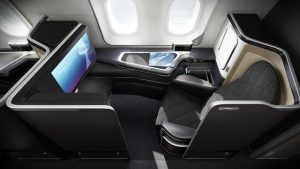The lie-flat airplane seat wasn’t exactly first invented by British Airways. Pan Am’s Boeing 314 Clipper “Flying Boats” had actual beds, as did BA’s predecessor, BOAC, which also operated 314s. But that was in the 1930s and 1940s.
However, in modern times, BA was the first to re-introduce fully-horizontal seat beds, starting with its first class cabins way back in 1996 and then with its 2000 launch of Club World business class, which underwent a major refresh six years later. And now, BA is ready to completely redesign its business class product, which will relaunch in stages beginning this year and culminating with a major change sometime in 2019 with the introduction of new 787-10 Dreamliner and Airbus A350 aircraft.
A little history
Other airlines were quick to copy the lie-flat concept, although some cheated by installing “angle flat” seats, which I never found comfortable (I always end up sliding down). Most airlines use what I call an infinitely adjustable “slide down” model where you press a button and the seat adjusts in increments between fully-flat and fully upright. Three airlines (Virgin Atlantic, Singapore Airlines, and Air New Zealand) employ a patented “flip down” model, which slides down only so far before you need to get up and flip the seat back down to form a bed. The flip-down model isn’t universally popular, but the idea is that you get to sleep on a more comfortable “bed surface,” plus these seats are less prone to mechanical breakdown (and they save fuel since there are fewer heavy motors); perhaps more importantly for some, if you drop your phone in between the seats there’s less chance it will get crushed when you operate the mechanism (trust me, this happens all the time so beware).
Some airlines add a mattress pad to put on top of the seats, making them cushier; others forgo this nicety (it makes a big difference).
What’s in store
And perhaps the biggest recent change in business class has been the move to all-aisle-access seating, usually in a 1-2-1 (one seat by each of the windows and two in the middle of the plane), or a staggered 2-4-2 configuration (used by Emirates on its A380 planes), so that passengers needn’t step over seat mates to get up.
And that will be the big change at BA, which promises all aisle access in business class, when it introduces its new planes. BA’s CEO Alex Cruz will not say what the new configuration or design will be but the best guess at this point, based on recent patent applications (part of which is shown above), is that it will be more evolutionary than revolutionary, keeping the current configuration (with seats facing forward and backward in a 2-4-2 or 2-3-2 pattern) but allowing passengers to gain the aisle without stepping over other passengers when their seats are in the lie-flat position. One thing for sure, there will be bigger in-flight entertainment screens and the new seats won't look like any other airline's seats. I'm pretty sure they'll keep those slide-up-and-down privacy screens, which I'm quite fond of.
While we wait to find out, BA is investing $500 million in other Club World enhancements to make the experience even plusher: improved pre-flight dining in upgraded lounges, more comfortable bedding (including a mattress pad and bigger pillows), more extensive in-flight meal service, super-fast next-gen Wi-Fi (which will appear in stages in all classes of service), among others.
And no matter which class you fly in, you’ll be fascinated by another BA initiative, this one at the airport: facial biometric, self-serve boarding gates, which I got to try out at London’s Gatwick Airport recently. Not only does this technology speed boarding, but it’s more secure and accurate than human facial recognition capabilities.






